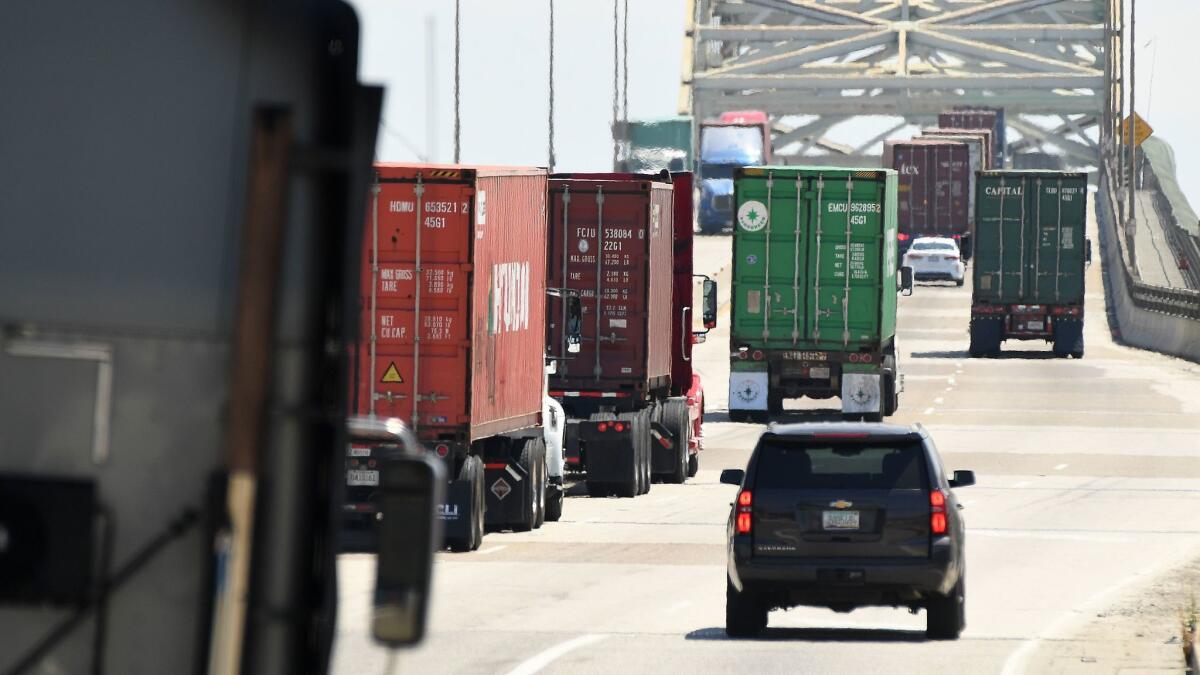Editorial: California is leading again on clean trucks and cleaner air

- Share via
Here’s one bright spot in an otherwise depressing 2020: Over the last few months, California has taken dramatic, landmark steps toward slashing emissions from heavy-duty diesel trucks that contribute heavily to smog, soot and planet-warming gases.
Over the next decade, California will require trucks sold in the state to be 90% cleaner than diesel models on the market today. At the same time, manufacturers will be required to roll out an increasing number of zero-emission trucks powered by batteries or fuel cells. With these new truck regulations, California is, again, leading the nation’s fight to clean the air and slow climate change.
The truck industry transformation will help protect residents living next to freeways, ports and warehouses, whose exposure to dangerously high levels of diesel exhaust puts them at greater risk of cancer, heart disease and respiratory problems. It will also help wean the transportation sector off fossil fuels; such a shift is essential to slowing the devastating climate change that we are already feeling in California.
In June, the California Air Resources Board adopted the United States’ first zero-emission truck mandate. The regulation requires manufacturers to begin selling zero-emission models in 2024 and to make those vehicles an increasing share of their sales each year until 2045, when all trucks sold in the state must be clean. The rule covers a range of trucks, including heavy-duty pickups, delivery vans, box trucks and big rigs.
The future of transportation is zero-emission vehicles — that is, if the world is going to successfully combat global climate change. But in the near term, there will still be thousands of diesel trucks sold each year, and California has an obligation to make sure those vehicles are as clean as possible.
The new truck regulation passed last week sets stringent new emissions standards for heavy-duty trucks, which include diesel-powered pickups, buses and semitrucks. Today, trucks are responsible for about one-third of the state’s smog-forming nitrogen oxides and one-quarter of its diesel soot. Under the new rule, such trucks sold in the state will be 90% cleaner by 2027 than models sold today. That’s the equivalent of taking 16 million cars off the road, or roughly two-thirds of the cars operating in the state today.
But there is a hitch: Roughly 40% of the trucks driven in California are from out of state and wouldn’t have to meet the strict standards. That’s why air quality and public health agencies have been pleading since 2016 for the U.S. Environmental Protection Agency to enact national standards.
Much to the surprise of some environmental groups, the Trump administration announced in 2018 that the EPA would propose a new Clean Trucks Initiative in early 2020. “We are doing it because it’s good for the environment,” EPA Administrator Andrew Wheeler said, noting the initiative would modernize truck engines, making them cleaner and more efficient.
But the good intentions didn’t last long. That initiative was put on hold, and the EPA hasn’t said if or when it will pursue cleaner truck engines.
California rightly chose not to wait for the federal government. But this puts the state in conflict again with the Trump administration, which has repeatedly tried to block California’s efforts to clean the air and fight global warming.
The Air Resources Board adopted the strict new trucks standards despite lobbying from engine manufacturers and the trucking industry. They argue the standards will make vehicles more expensive — a new truck engine would cost about $6,000 more over its lifetime — and put California companies at a competitive disadvantage if they have to pass those costs along to consumers.
The costs, however, are far outweighed by what the public will gain from the rule, especially in communities with dirty, unhealthy air. More broadly, the new standard will help Southern California and the San Joaquin Valley meet EPA deadlines to clean up the regions’ smoggy, sooty air and avoid significant federal penalties.
The Air Resources Board also voted last week to require more cargo ships to turn off their engines or plug in to shore-based power supplies while they are docked. This will help cut diesel pollution in port communities such as Los Angeles, Long Beach and Oakland.
These are all vital steps toward cleaning up the transportation and freight sectors. California can’t have clean air without cleaner vehicles, and the world can’t slow climate change without reducing our reliance on fossil fuels.
More to Read
A cure for the common opinion
Get thought-provoking perspectives with our weekly newsletter.
You may occasionally receive promotional content from the Los Angeles Times.










